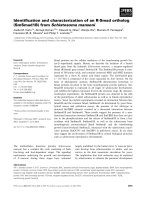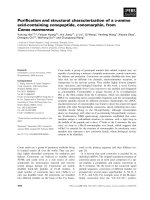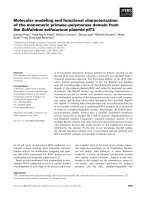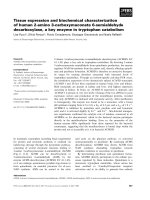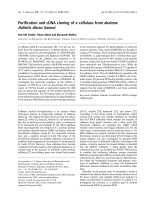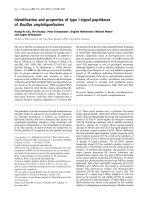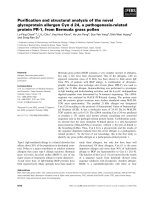Báo cáo khoa học: Identification and biochemical characterization of the Anopheles gambiae 3-hydroxykynurenine transaminase pot
Bạn đang xem bản rút gọn của tài liệu. Xem và tải ngay bản đầy đủ của tài liệu tại đây (221.28 KB, 10 trang )
Identification and biochemical characterization of the
Anopheles gambiae 3-hydroxykynurenine transaminase
Franca Rossi
1
, Fabrizio Lombardo
2
, Alessandra Paglino
1
, Camilla Cassani
1
, Gianluca Miglio
1
,
Bruno Arca
`
2,3
and Menico Rizzi
1
1 DiSCAFF, University of Piemonte Orientale ‘Amedeo Avogadro’, Novara, Italy
2 Dipartimento di Scienze di Sanita
`
Pubblica – Sezione di Parassitologia, Universita
`
di Roma ‘La Sapienza’, Italy
3 Dipartimento di Biologia Strutturale e Funzionale, Universita
`
di Napoli ‘Federico II’, Italy
In the last decades, the catabolic intermediates arising
from the main pathway for tryptophan oxidative de-
gradation, collectively known as kynurenines, have
received great attention on account of their roles in the
physiological tuning of the central nervous system and
in the etiogenesis and progression of several human
neurodegenerative diseases (reviewed in [1–4]). One of
the most powerful cytotoxic metabolites of the kynure-
nine pathway is the 3-hydroxykynurenine (3-HK),
which is generated in the third step of the catabolic
cascade, through the hydroxylation of the central com-
mon precursor l-kynurenine (L-KYN) [5–7]. Sponta-
neous oxidation of the 3-HK induces free radical
generation and apoptosis as shown both in vitro and in
animal models [8,9]. Mammals can scavenge the poten-
tially toxic 3-HK excess either by converting 3-HK
to xanthurenic acid (XA) by direct transamination or
by hydrolysing the molecule to produce alanine and
3-hydroxyanthranilic acid (3-HAA); this metabolic
intermediate is then fluxed into the central branch of
the catabolic cascade, resulting in the de novo synthesis
of the essential cofactor NAD [10]. 3-Hydroxykynure-
nine detoxification is a metabolic priority also for the
vast majority of other living species that depend on
Keywords
Anopheles gambiae; 3-hydroxykynurenine
transaminase; xanthurenic acid; Plasmodium
gametogenesis; PLP dependent enzyme
Correspondence
M. Rizzi, DiSCAFF, University of Piemonte
Orientale ‘Amedeo Avogadro’, Via Bovio 6,
28100 Novara, Italy
Fax: +39 0321375821
Tel: +39 0321375812
E-mail:
(Received 26 July 2005, revised 31 August
2005, accepted 6 September 2005)
doi:10.1111/j.1742-4658.2005.04961.x
Spontaneous oxidation of 3-hydroxykynureine (3-HK), a metabolic inter-
mediate of the tryptophan degradation pathway, elicits a remarkable oxida-
tive stress response in animal tissues. In the yellow fever mosquito Aedes
aegypti the excess of this toxic metabolic intermediate is efficiently removed
by a specific 3-HK transaminase, which converts 3-HK into the more sta-
ble compound xanthurenic acid. In anopheline mosquitoes transmitting
malaria, xanthurenic acid plays an important role in Plasmodium gameto-
cyte maturation and fertility. Using the sequence information provided by
the Anopheles gambiae genome and available ESTs, we adopted a PCR-
based approach to isolate a 3-HK transaminase coding sequence from the
main human malaria vector A. gambiae. Tissue and developmental expres-
sion analysis revealed an almost ubiquitary profile, which is in agreement
with the physiological role of the enzyme in mosquito development and
3-HK detoxification. A high yield procedure for the expression and purifi-
cation of a fully active recombinant version of the protein has been devel-
oped. Recombinant A. gambiae 3-HK transaminase is a dimeric pyridoxal
5¢-phosphate dependent enzyme, showing an optimum pH of 7.8 and a
comparable catalytic efficiency for both 3-HK and its immediate catabolic
precursor kynurenine. This study may be useful for the identification of
3-HK transaminase inhibitors of potential interest as malaria transmission-
blocking drugs or effective insecticides.
Abbreviations
3-HAA, 3-hydroxyanthranilic acid; 3-HK, 3-hydroxykynurenine; 3-HKT, specific 3-hydroxykynurenine transaminase; KA, kynurenic acid; KAT,
kynurenine aminotransferase; L-KYN,
L-kynurenine; PLP, pyridoxal 5¢-phosphate; UTR, untranslated region; XA, xanthurenic acid.
FEBS Journal 272 (2005) 5653–5662 ª 2005 FEBS 5653
the kynurenine pathway for dietary tryptophan oxida-
tion and that are sensitive to the potential toxic effects
of its intermediate metabolites. Indeed, in adult insects
of different species, exogenously administered kynure-
nines can have a deep impact on complex behaviours
[11] and locomotive activity [12,13]; this impairment
can culminate with the irreversible paralysis of the
insect and death [14]. Interestingly, it has been shown
that 3-HK can produce its effects by a direct killing
of neurons, through a well characterized series of cyto-
pathological events which have several traits in com-
mon with the rat striatum neuron apoptotic death
induced by 3-HK treatment [15].
So far a specific 3-hydroxykynurenine transaminase
(3-HKT) function has not been identified in man. In
fact, in mammals 3-HK can undergo two alternative
fates: it can be hydrolysed to 3-HAA through the
action of a specific kynureninase [16] or, as alternative,
it can be transformed to XA by the same pyridoxal
5¢-phosphate (PLP)-dependent kynurenine amino-
transferase (KAT) isozymes that catalyse the irrevers-
ible transamination of L-KYN to kynurenic acid (KA)
[17–19].
In the yellow fever mosquito Aedes aegypti, a kynu-
reninase enzymatic activity has never been documented;
therefore, the detoxification of 3-HK should rely totally
on the capability of the insect to transform 3-HK into
the more stable XA. Initially it was assumed that
A. aegypti KAT [20] could sustain both L-KYN and
3-HK transamination in the mosquito, similar to what
is observed for the human enzyme. However, this hypo-
thesis has been recently disproved by the observation
that A. aegypti KAT has no activity towards 3-HK
and by the discovery of a specific 3-HKT enzyme
(Ae-HKT ⁄ AGT), catalysing the irreversible transamina-
tion of 3-HK to XA [21,22]. An increasing number of
molecular and developmental studies highlighted the
essential role of XA in the gametogenesis and fertility of
the malaria parasite [23,24]. Very recently, the molecu-
lar details of the signalling cascade triggered by XA and
resulting in the maturation of Plasmodium gametes have
been elucidated [25]. Overall, the available data point to
XA metabolism as a likely crucial crossroad in the bio-
logy of Plasmodium development into the mosquito.
However, very little is known about how anophelines
deal with metabolic 3-HK excess. In particular, the bio-
chemical aspects of the 3-HK dependent synthesis of
XA in Anopheles gambiae, the most efficient vector of
the most deadly malaria parasite P. falciparum, remain
elusive. We report here the identification, the bacterial
heterologous expression and the biochemical characteri-
zation of 3-HKT from A. gambiae. These results repre-
sent the first biochemical report concerning an enzyme
involved in the kynurenine pathway in A. gambiae. Our
analysis on 3-HKT contributes to a better understand-
ing of the XA metabolism in the mosquito and offers a
new possible target for the development of insecticides
and ⁄ or transmission blocking agents.
Results and Discussion
Isolation of the A. gambiae 3-HKT cDNA
In order to isolate the A. gambiae 3-HKT cDNA, the
sequence of the Aedes aegypti enzyme (Ae-HKT ⁄ AGT,
accession number AF435806) [21] was used to search
the A. gambiae genome by the blast search tool
[26,27]. A genomic region whose conceptual translation
showed high level of similarity to the Aedes aegypti
enzyme was retrieved; this sequence was used to search
the EST database allowing for the identification of two
nonoverlapping ESTs probably representing the 5¢-end
(BM637288) and the 3¢-end (BM603618) of the 3-HKT
A. gambiae cDNA. Oligonucleotide primers matching
these ESTs were used to amplify by RT-PCR the puta-
tive coding region of the A. gambiae 3-HKT cDNA.
This strategy allowed for the isolation of a 1400-bp
long cDNA clone (accession number AM042695);
according to the expected function of the encoded
protein, we named the corresponding gene Ag-hkt.
Sequence analysis revealed that the Ag-hkt cDNA
clone contains a single 1188-bp long ORF (position
174–1361 in Fig. 1) flanked by two short untranslated
regions (UTRs). The conceptual translation of this
ORF resulted in a 396-amino acid long protein, repre-
senting the A. gambiae 3-HKT.
Expression profile of the 3-HKT gene
The expression of the Ag-hkt gene was analysed by
RT-PCR amplification of the corresponding mRNA
from different A. gambiae developmental stages and
from a few selected adult tissues. As shown in Fig. 2,
Ag-hkt is expressed at significantly high levels through-
out embryonic ⁄ larval development and in both adult
males and females, whereas expression is very low or
absent during the pupal stage. This developmental pat-
tern of expression is on line with earlier observations
made in A. aegypti and with the physiological need of
the mosquito to keep 3-HK under stringent control
[21,28]. Indeed, during embryo and larval development
and in mosquito adulthood, the expression of Ag-hkt
is important in protecting insect tissues from the
3-HK-triggered oxidative stress response. On the other
hand, downregulation of Ag-hkt expression in pupae is
in agreement with the physiological 3-HK requirement
A. gambiae 3-hydroxykynurenine transaminase F. Rossi et al.
5654 FEBS Journal 272 (2005) 5653–5662 ª 2005 FEBS
for the production of ommochromes during compound
eye development [29,30]. Moreover, in vivo develop-
mental studies suggest that 3-HK may play an active
role in tissue remodelling during neurometamorphosis
by induction of free radical generations and apoptosis
[31]. As far as tissue-specific expression is concerned,
high levels of Ag-hkt expression were found in ovaries
and in the gut (Fig. 2, lane 6 and 7). These observa-
tions fit well both with the previously reported expres-
sion in the developing ovaries of Aedes aegypti [21] as
well as with the involvement of the enzyme in the oxi-
dative degradation of dietary tryptophan. Moreover, a
recent microarray analysis includes the Ag-hkt among
a group of genes that are upregulated upon blood-
feeding in A. gambiae [32]. The very low or almost
undetectable expression in the salivary glands (Fig. 2,
lane 5) is somehow unexpected because XA has been
found in A. stephensi saliva [33]; indeed, it has been
suggested that salivary glands may represent an
important source of XA which would be delivered into
the host with saliva during blood-feeding and then
ingested along with blood into the midgut [33]. The
results of our tissue-specific expression analysis are in
agreement with a recent study on the A. gambiae tran-
scriptome that failed to reveal Ag-hkt mRNA among
over 850 salivary transcripts [34]. Therefore, we suggest
that the involvement of salivary glands in the supply
of the gametocyte activating factor XA may be of
limited importance in comparison to that of the
midgut. Overall the observed Ag-hkt expression profile
closely resembles the one reported for the Ae-HKT ⁄
AGT [21] and points to the mosquito 3-HKT as a
possible novel target for the development of insecticides
which, by targeting both the larval and adult stages of
5'- tgttacggtagcggtacctgttt
gccgaagtgttgtcagcttggtgttctagagtgagggtataactaacgctgccctaaagttggaagaaggggaataacgtaaacgacaca
cctcagtgacattgtgcgaattgtcccgtattgtattaacttactgaaagtgctgatacaatgaagttcacgccgccccctgcatcgcta
MKFTPPPASL
cgcaatcctttaatcattccggaaaagataatgatgggccctggaccgtccaactgctcaaagcgggtgctgactgccatgactaacacc
RNPLIIPEKIMMGPGPSNCSKRVLTAMTNT
gtgctgagcaacttccacgctgaattgttccgaacgatggacgaggtcaaggatggcttgcggtacatttttcagacagaaaaccgggcc
VLSNFHAELFRTMDEVKDGLRYIFQTENRA
actatgtgcgtaagcggttccgcacacgcgggaatggaagctatgctgagcaatctgcttgaagagggcgatcgagtgctgatcgcggtt
TMCVSGSAHAGMEAMLSNLLEEGDRVLIAV
aacggaatttgggcagagcgtgccgtcgaaatgtctgagcgatacggtgccgatgttcgaacgattgagggccctccggaccgcccgttc
NGIWAERAVEMSERYGADVRTIEGPPDRPF
agtttggaaacattggccagagccatcgaactgcatcaacccaagtgtctgttcctgacgcacggtgactcatcaagtggtctgctgcag
SLETLARAIELHQPKCLFLTHGDSSSGLLQ
ccgctggaaggtgtaggccagatttgtcaccagcacgactgtttgctcatcgttgatgccgtggcttcgctgtgcggtgtgccattttat
PLEGVGQICHQHDCLLIVDAVASLCGVPFY
atggataaatgggagattgatgccgtctatactggagcgcaaaaggtgctaggtgcgcctcctggtatcactcccatttctataagcccg
MDKWEIDAVYTGAQKVLGAPPGITPISISP
aaagcactggatgttattcgaaatcgtcgtacaaaatcgaaagtattttactgggatttactgctgcttggcaattattggggctgttat
KALDVIRNRRTKSKVFYWDLLLLGNYWGCY
gatgaaccaaaacgttatcaccatactgtcgcatcgaacttaatatttgctctgcgggaagcattggctcaaattgcggaagaaggactg
DEPKRYHHTVASNLIFALREALAQIAEEGL
gaaaatcagatcaaacgccgcatcgaatgtgcccaaatcttgtacgaagggcttggtaagatgggactcgatattttcgtgaaagacccc
ENQIKRRIECAQILYEGLGKMGLDIFVKDP
agacatcgcctgcccaccgtaactggtattatgattccgaaaggtgttgactggtggaaagtttcacaatacgccatgaacaatttttcg
RHRLPTVTGIMIPKGVDWWKVSQYAMNNFS
ttagaagtacaaggaggacttggacctacgtttggaaaagcatggcgtgtgggtattatgggcgaatgctcaacggtacaaaaaatacaa
LEVQGGLGPTFGKAWRVGIMGECSTVQKIQ
ttctatctatatggctttaaggaatcactcaaagccacgcatcccgactatattttcgaggaaagtaatggatttcactagacgaaactt
FYLYGFKESLKATHPDYIFEESNGFH
aaacaatgcatcaatgtattattgccg - 3'
Fig. 1. Sequence analysis of the A. gambiae 3-HKT. The full length sequence of the isolated Ag-hkt cDNA clone: the putative translation start
codon and stop codon are shown in bold. The primary sequence of the conceptual translation product Ag-HKT is shown.
1 234 56789
ag-hk
t
rpS7
Fig. 2. Developmental- and tissue-specific Ag-hkt expression analysis. RT-PCR amplification of total RNA from different tissues and develop-
mental stages with Ag-hkt- and rpS7 -specific primers. Lanes: 1, embryos; 2, larvae; 3, pupae; 4, adult females; 5, salivary glands; 6, ovaries;
7, midgut; 8, carcasses (adult females with salivary gland, ovaries and gut removed); 9, adult males.
F. Rossi et al. A. gambiae 3-hydroxykynurenine transaminase
FEBS Journal 272 (2005) 5653–5662 ª 2005 FEBS 5655
the mosquito, would represent a valuable tool for
fighting mosquito-borne diseases by vector control.
Recombinant Ag-HKT bacterial expression and
enzyme purification
To obtain large amounts of highly purified A. gambiae
3-HKT for subsequent enzymatic studies, we expressed
the corresponding coding sequence in a bacterial high-
producing system. To this end, we subcloned the PCR
amplified Ag-hkt orf into the NcoI ⁄ XhoI site of the
pET-16b plasmid, thus eliminating the vector region
encoding the standard poly-histidine tract. The result-
ing pET ⁄ Ag-hkt construct drives, in Escherichia coli,
the T7-dependent expression of a no-tags bearing, 396-
amino acid long recombinant version of the mosquito
enzyme (Ag-HKT). The SDS ⁄ PAGE analysis (Fig. 3,
lane A) reveals that the recombinant Ag-HKT (predic-
ted relative molecular mass, 44 298 Da) represents the
major band in the soluble fraction of a lysate from
pET ⁄ Ag-hkt transformed E. coli BL21(DE3) cells. The
starting relative abundance of the recombinant
Ag-HKT ( 50% of soluble proteins), together with
an intrinsic robustness of the enzyme, allowed us to
adopt a simple protocol for its purification to homo-
geneity, consisting of a preliminary ammonium sul-
phate fractionation followed by three FPLC steps
exploiting anion exchange media displaying increasing
separation power. This purification procedure repro-
ducibly yielded 8 mg of 99% pure recombinant
Ag-HKTÆL
)1
of transformed bacterial culture (Fig. 3,
lane B). The purified protein was yellow in colour and
aUV⁄ VIS spectroscopic analysis (Fig. 3, panel C)
revealed the classic spectral profile for a PLP-bound
aminotransferase, where the peak at 410 nm corres-
ponds to the internal aldimine form of the cofactor
[35,36]. The absorption spectra at different pH values
ranging from 6.0 to 9.0 were also measured. Differ-
ently to what was observed in other PLP-dependent
enzymes, such as aspartate aminotransferase and
1-aminocyclopropane-1-carboxylate synthase [37],
Ag-HKT does not exhibit a pH dependent spectrum of
its internal aldimine (data not shown).
Moreover, the recombinant Ag-HKT was able to
catalyse 3-HK transamination (see hereafter), definit-
ively confirming that we had isolated a full-length
cDNA clone encoding a functional protein. Size exclu-
sion chromatography performed on the pure and act-
ive enzyme revealed a dimeric quaternary assembly for
the recombinant protein (data not shown). Table 1
summarizes the 3-HKT specific activity recovered after
each purification step.
Substrate specificity and kinetic analysis of the
recombinant Ag-HKT
Enzymatic assays demonstrated that Ag-HKT cata-
lyses the transamination of both 3-HK and kynurenine
to XA and KA, respectively, using different a-keto-
acids as amino group acceptor cosubstrates. Among
MWM
(kDa)
BA
29
45
66
116
97
Abs
300 350 400 450 500 550 600
0.000
0.010
0.020
0.030
0.040
0.050
0.060
0.070
0.080
0.090
0.100
nm
C
410 nm
Fig. 3. Analysis of the bacterial expressed and purified Ag-HKT. Analysis by SDS ⁄ PAGE of the protein content of the pET ⁄ Ag-hkt trans-
formed E. coli BL21(DE3) clarified lysate (A) and of the purified recombinant enzyme (B); samples were separated on a 10% polyacrylamide
gel and stained by Coomassie blue. The arrowhead points to the overexpressed Ag-HKT and to the recovered enzyme at the end of the puri-
fication procedure. MWM: relative molecular mass markers (kDa). (C) Absorption spectrum of the internal aldimine of a 10 l
M solution of
Ag-HKT in 200 m
M potassium phosphate (pH 7.0) at 25 °C. The arrowhead indicates to the 410 nm maximum absorption peak.
A. gambiae 3-hydroxykynurenine transaminase F. Rossi et al.
5656 FEBS Journal 272 (2005) 5653–5662 ª 2005 FEBS
these, the maximal activity towards both 3-HK and
L-KYN was observed with glyoxylate; pyruvate effi-
ciently substituted for glyoxylate only in the Ag-HKT
catalysed transamination of 3-HK, whereas oxaloace-
tate and a-ketobutyrate acted as less efficient amino
acceptors with both substrates (Table 2). Conse-
quently, the determination of the kinetic parameters of
the Ag-HKT catalysed reactions was invariably per-
formed using glyoxylate as the cosubstrate.
Because pure L-3-HK is not available from any com-
mercial source, all of the data presented refer to experi-
ments performed by using a racemic mixture of l- and
d-3-HK (d,l-3HK in Tables 2 and 3). To compare
the catalytic parameters featuring Ag-HKT activity
towards l-3-hydroxykynurenine and l-kynurenine, we
performed the kinetic analysis also by using d,l-KYN,
a racemic mixture of kynurenine equivalent to that
used in the case of 3-HK. The kinetic parameters deter-
mined in the case of d,l-3HK and d,l-KYN (Tables 2
and 3) allowed us to conclude that A. gambiae 3-HKT
displays comparable affinity and catalytic efficiency for
the two substrates, as previously reported for the Aedes
aegypti enzyme [21,22]. Neither the substrates nor the
products of the Ag-HKT-dependent reactions exerted
any inhibitory effect on the catalysis, which follows a
classical Michaelis–Menten kinetics. Moreover, we tes-
ted the effect on the 3-HK transamination catalysed by
Ag-3HKT, of all the natural amino acids at a concen-
tration of 1 mm without observing any enzyme inhibi-
tion (data not shown). The concentration we used in
these experiments greatly exceeds the one present in a
typical mosquito blood meal [38]. Therefore, the Ag-
HKT capability of sustaining the necessary synthesis of
XA in the mosquito midgut is not expected to be signi-
ficantly influenced by other amino acids present in the
blood meal.
The effect of pH and temperature on Ag-HKT
catalysed synthesis of XA
We examined next the pH optimum and temperature
dependence of the 3-HK transamination catalysed by
the purified recombinant Ag-HKT. Of functional rele-
vance, the enzyme possesses a pH optimum of 7.8
(Fig. 4A); this value is close to the pH range of 7.5–
7.7 recorded in the midgut of A. stephensi females after
blood feeding [39]. Interestingly, although Ag-3HKT
and Aa-3HKT show a sequence identity of 79%, a
sharp difference in their optimum pH is observed, with
the Aedes aegypti enzyme displaying an optimum pH
of 9.0 [21].
Such an observation suggests that fine tuning of
A. gambiae 3-HKT activity is likely to be instrumental
Table 1. Recombinant Ag-HKT purification procedure. The starting
amount of soluble proteins in the lysate form pET ⁄ ag-hkt trans-
formed bacteria and the proteins content after each purification
step were quantified by Bradford assays. The specific transamina-
tion activity towards 3-HK of each purification sample was deter-
mined as described in Experimental procedures using glyoxylate as
the amino acceptor substrate.
Purification
step
Total
protein
(mg)
Specific
activity
(lmolÆmin
)1
Æmg
)1
)
Total
activity
(lmolÆmin
)1
)
Activity
yield
(%)
Lysate (soluble
fraction)
594.4 10.3 6122.3 100
Ammonium
sulfate
precipitation
272 11.7 3182.4 52
HiTrap Q 109 17.7 1929.3 31.5
Source Q 28 26.3 736.4 12
Mono Q 13.4 32.6 436.8 7
Table 2. Ag-HKT specificity towards different amino acceptors.
Data are expressed as percentage of the activity obtained using
glyoxylate as the a-ketoacid amino acceptor in the Ag-HKT cata-
lysed transamination of
D,L-3HK or L-KYN as detailed in Experimen-
tal procedures.
Cosubstrate
Amino acid substrate
Glyoxylate Pyruvate Oxalacetate a-Ketobutyrate
D,L-3HK 100 96.8 55.4 52.7
L-KYN 100 59.5 62.1 41.2
Table 3. Kinetic parameters for Ag-HKT. Kinetic parameters of the transamination reactions of Ag-HKT towards D,L-3HK, D,L-KYN, L-KYN
were determined by using glyoxylate as the a-ketoacid amino acceptor, whereas the corresponding values for glyoxylate were determined
by using
D,L-3HK as the amino donor. Each assay has been performed in triplicate.
Substrate K
m
(mM) V
max
(lmolÆmin
)1
) k
cat
(min
)1
) k
cat
⁄ K
m
(min
)1
ÆmM
)1
)
D,L-3HK 2.0 ± 0.3 0.044 ± 0.005 988.5 ± 113 494.3 ± 80
D,L-KYN 2.3 ± 0.3 0.048 ± 0.013 1077.2 ± 284 468.3 ± 44
L-KYN 1.0 ± 0.4 0.028 ± 0.009 611.5 ± 214 611.5 ± 9
Glyoxylate 2.7 ± 0.1 0.102 ± 0.003 2264.8 ± 67.9 838.8 ± 48.9
F. Rossi et al. A. gambiae 3-hydroxykynurenine transaminase
FEBS Journal 272 (2005) 5653–5662 ª 2005 FEBS 5657
to an efficient synthesis of XA in mosquito midgut. The
curve of the enzymatic activity as a function of tem-
perature, revealed that Ag-HKT is highly thermostable
and works well in a wide temperatures interval, ranging
from 25° to 65 °C, with a maximum activity peak, in
our in vitro tests, at 60 °C (Fig. 4B). However, it should
be noted that at 30 °C, i.e. at temperatures close
to physiological values, the recombinant enzyme still
works at 60–65% of its maximum, with an activity of
20 lmolÆmin
)1
Æmg
)1
. Of note is that in the same con-
ditions, the A. aegypti homologue functions at 20%
of its maximum [21], with an activity that is four times
lower than that of the A. gambiae enzyme ( 5 lmolÆ
min
)1
Æmg
)1
). The possible physiological ⁄ functional
significance and the implications of these differences
between the Aedes aegypti and the A. gambiae enzymes
are presently unclear; however, it should be noted that
P. gallinaceum, a parasite species that is transmitted by
Aedes aegypti, requires in vitro XA concentration of
80 nm for the induction of gametogenesis at half-
maximal response (EC
50
), whereas P. falciparum and
P. berghei, that are transmitted by anopheline mosqui-
toes, require concentrations of XA that are of 2 lm and
9 lm, respectively, i.e. 25–100 times higher [40].
Overall, we have shown here that the A. gambiae
Ag-hkt gene is expressed at relatively high level in the
midgut and that the encoded 3-HKT enzyme acting on
the 3-HK produced by the oxidative degradation of
the tryptophan after blood feeding, may represent the
major source of mosquito-derived XA, a key inducer
of gametogenesis and a crucial player in the initiation
of parasite development into the mosquito.
Conclusions
Plasmodium male gametocytes full maturation, thr-
ough the spectacular phenomenon of exflagellation
[41], requires the presence of XA which is needed
in vitro in the micromolar range for most Plasmo-
dium species [40]. In principle, XA may potentially
derive from the tryptophan metabolism of any of the
three organisms involved in malaria: the vector, the
vertebrate host and the parasite. However, the para-
site itself does not give any contribution and the
average XA concentration in human blood has been
determined to be in the 0.6–2 lm range [42], a value
that would theoretically support exflagellation of
P. falciparum at 13–50% maximal efficiency [40], sug-
gesting that endogenously mosquito-produced XA
may be of key importance for sustaining exflagella-
tion. Interestingly, a putative 3-HKT gene has
recently been shown to be highly upregulated in
A. gambiae adult females fed with P. bergheii infected
blood [43]. Within such a scenario, the isolation and
biochemical characterization of recombinant A. gambiae
3-HKT that we report here, represents a step for-
ward into the understanding of XA metabolism in
Fig. 4. The effect of pH and temperature on Ag-HKT-mediated cata-
lysis. (A) The optimum pH for Ag-HKT was monitored following a
5-min incubation of the samples at 50 °C. In each test,
D,L-3HK and
glyoxylate were used as the amino donor and acceptor, respect-
ively; the reaction mixtures were prepared in buffer phosphate at
5.5, 6.5, 7.4, 7.8, 8.0, 8.5, 9.0 pH values. (B) The temperature
dependence of Ag-HKT catalysed reaction was monitored at either
pH 7.8 (filled squares) or pH 7.0 (open squares) by incubating the
corresponding samples 5 min at 23, 37, 50, 60, 80, 100 °C. Each
assay was initiated by the addition of 2 lg of the purified enzyme
to the prewarmed reaction mixtures. All experiments were per-
formed in triplicate.
A. gambiae 3-hydroxykynurenine transaminase F. Rossi et al.
5658 FEBS Journal 272 (2005) 5653–5662 ª 2005 FEBS
A. gambiae and will be useful for the identification of
enzyme inhibitors of potential interest as malaria
transmission-blocking drugs and⁄ or effective insecti-
cides.
Experimental procedures
Mosquito colony
The A. gambiae used in this study is the GASUA reference
strain (Xag, 2R, 2La, 3R, 3 L, SuaKoKo, Liberia) main-
tained under standard conditions. The different tissues and
developmental stages were collected, immediately frozen in
liquid nitrogen and stored at )80 °C until used for RNA
extraction. Tissues were dissected in a few drops of
NaCl ⁄ P
i
and stored in ice for no longer than 60 min before
freezing.
3-HKT cDNA cloning and expression analysis
Nucleic acid manipulations, if not otherwise specified, were
performed according to standard procedures [26] or follow-
ing manufacturers’ instructions. Total RNA was extracted
from the different tissues and developmental stages using
the TRIZOL Reagent (Invitrogen, Carlsbad, CA, USA).
Approximately 80 ng DNase I-treated RNA (RNase-free
DNase I, Invitrogen) extracted from 2–4-day old adult
females were used for the cDNA amplification by the
SuperScript one-step RT-PCR system (Invitrogen). Reverse
transcription (50 °C, 30 min) and heat inactivation of the
reverse transcriptase (94 °C, 2 min) were followed by 35
cycles of amplification (30 s, 94 °C; 30 s, 58 ° C; 90 s,
72 °C) and a final elongation of 7 min at 72 °C. The ampli-
fication product was digested with BamHI and EcoRI, gel
purified, cloned into the pBCKSII vector (Stratagene, La
Jolla, CA, USA) and sequenced. Forward and reverse prim-
ers, containing at their ends, respectively, BamHI and
EcoRI restriction sites, were designed using the sequence
information from the two nonoverlapping ESTs BM637288
and BM603618 representing the putative 5¢-UTR and
3¢-UTR of the A. gambiae 3-HKT. The sequence of the
oligonucleotide primers was: hkt1BamF, 5¢-GATCGGATC
CTGTTACGGTAGCGGTACCTG-3¢; hkt1EcoR, 5¢-CAT
GGAATTCCGGCAATAATACATTGATGC-3¢.
For the expression analysis approximately 80–100 ng of
DNase I-treated total RNA were amplified by the Super-
Script one-step RT-PCR system using the following Ag-hkt
and rpS7 (ribosomal protein S7) oligonucleotide primers:
hktF, 5¢-TGTAGGCCAGATTTGTCACC-3¢,hktR.5¢-CCTT
CTTCCGCAATTTGAGC-3¢; rpS7F, 5¢-GGCGATCATCA
TCTACGTGC-3¢; rpS7R, 5¢-GTAGCTGCTGCAAACTT
CGG-3¢. Briefly, reverse transcription (50 °C, 30 min) and
heat inactivation of the reverse transcriptase (94 °C, 2 min)
were followed by 35 cycles of amplification (30 s, 94 °C;
30 s, 55 °C; 60 s, 72 °C) and a final elongation of 7 min at
72 °C. Twenty-five cycles were used for the amplification of
rpS7 mRNA in order to keep the reaction below saturation
and to allow a more reliable normalization. The different
stages used for expression analysis were: embryos, 0–48 h;
larvae, first to fourth instar larvae; pupae, early and late
pupae; 2–4 day-old adult females; 2–4 day-old adult males.
Tissues were dissected from adult females 2–4 days after
emergence. Carcasses were adult females without salivary
glands, ovaries and gut.
Recombinant bacterial expression vector
construction
The 1191-bp Ag-HKT coding sequence, from the putative
translational ATG to the end of the ORF, was amplified by
PCR using the corresponding A. gambiae cDNA clone (see
above) as the template. The PCR primers used were:
for_3hkt, 5¢-TTAACCATGGTGAAGTTCACGCCGCCCC
CT-3¢; rev_3hkt, 5¢-TTAACTCGAGTCTAGTGAAATCCA
TTACTTTCCTC-3¢ and they were designed to contain,
respectively, the NcoI and the XhoI restriction sites at their 5¢
ends (in italic). The NcoI–XhoI digested PCR product was
ligated into NcoI–XhoI linearized pET16b vector (Novagen,
Madison, WI, USA), resulting in the pET ⁄ Ag-hkt construct.
Ag-HKT bacterial expression and recombinant
enzyme purification
Several colonies of E. coli BL21(DE3) freshly transformed
with the pET ⁄ ag-hkt construct, were inoculated in 1 litre of
Luria–Bertani medium (50 lgÆmL
)1
ampicillin), and grown
at 22 °C under vigorous shaking. At 18 h postinoculation,
bacteria were collected by centrifugation (11 000 g for
15 min at 4 °C) and resuspended in 40 mL lysis solution
consisting of 100 mm phosphate buffer, pH 6.8, 40 lm PLP
and protease inhibitor cocktail. After ultrasonication on
ice, the bacterial lysate was clarified by centrifugation
(14 000 g for 45 min at 4 °C) and ammonium sulphate was
added to the resulting supernatant (20% saturation). Preci-
pitated proteins were removed by low speed centrifugation
(10 000 g for 30 min at 4 °C) and the soluble material was
further fractionated in 50% saturated ammonium. The pre-
cipitate was collected as above, resuspended in 15 mL puri-
fication buffer (20 mm Tris ⁄ HCl pH 8.0, 40 lm PLP
and proteases inhibitor cocktail) and extensively dialysed.
Recombinant Ag-HKT was purified by FPLC chromato-
graphy (Akta Basic instrument, Amersham Pharmacia
Biosciences, Milan, Italy) using, in sequence, HiTrapQ,
SourceQ and MonoQ prepacked anion exchange media
(Amersham Pharmacia Biosciences). A linear 0.0–0.5 m
NaCl gradient was invariably used to elute retained pro-
teins. Flow-through protein content was monitored by a
double wavelength reading at 280 nm (total proteins) and
F. Rossi et al. A. gambiae 3-hydroxykynurenine transaminase
FEBS Journal 272 (2005) 5653–5662 ª 2005 FEBS 5659
at 425 nm (internal aldimine form of the PLP cofactor).
Cromatographic fractions showing absorbance at 425 nm
were analysed by standard SDS ⁄ PAGE. Pure Ag-HKT
containing fractions from the last chromatographic step
were pooled, dialysed against 20 mm Tris ⁄ HCl pH 8.0,
150 mm NaCl and concentrated by ultrafiltration using a
30 000 MWCO disposable device. The Ag-HKT concentra-
tion was determined by a Bradford assay, using BSA as the
standard. The purity of the recombinant enzyme was
assessed by standard SDS ⁄ PAGE analysis. UV ⁄ visible
absorption spectra of the purified recombinant Ag-HKT
were measured by using a UV ⁄ VIS spectrometer at room
temperature. A 10-lm enzyme solution was scanned within
the 300–650 nm wavelength interval. Aliquots of Ag-HKT,
supplemented by 40 lm PLP and proteases inhibitor cock-
tail, were stored at 4 ° C (up to 1 week storage) or at
)80 °C (long-term storage).
Recombinant Ag-HKT biochemical
characterization
The activity of bacterial expressed Ag-HKT was assayed by
measuring the amount of XA produced following the incuba-
tion of the enzyme with d,l-3HK as amino group donor in
the presence of different a-ketoacids as amino group accep-
tors, according to literature [21,22]. Two micrograms of
recombinant Ag-HKT were incubated at 50 °C in 200 mm
potassium phosphate buffer pH 7.0, 40 lm PLP and 5 mm
d,l-3HK in presence of either 5 mm glyoxylate, pyruvate,
a-ketobutyrate or oxalacetate, in a final reaction volume of
50 lL. Each reaction was started by the addition of the
enzyme and stopped after 5 min by adding an equal volume
of formic acid (0.8 m). The precipitated enzyme was removed
by centrifugation at 16 000 g for 10 min at 4 °C and a 20-lL
aliquot of the resulting supernatants was injected into a
HPLC-UV system (System Gold, Beckman Coulter, Milan,
Italy) equipped with a C-18 sphereclone ODS [2] analytical
column (5 lm particle size, 250 · 4.0 mm; Phenomenex,
Torrance, CA, USA). The mobile phase (50 mm potassium
phosphate buffer, pH 4.8, 10% v ⁄ v acetonitrile) was deliv-
ered at a flow-rate of 1 mLÆ min
)1
at room temperature and
the XA formation was monitored by UV absorbance meas-
urement at 330 nm. Identification of each compound in the
assay mixture was based on its specific retention time and
coelution with each standard. To quantify the XA produced
in each experiment, a calibration curve was constructed using
the same HPLC-UV experimental setting. To check the ami-
notransferase activity of the recombinant Ag-HKT towards
kynurenine, an identical approach was followed, substituting
either l-KYN or d,l-KYN for 3-HK as amino group donors
and fixing at 5 mm the amino group acceptor glyoxylate (see
Results). The synthesis of the transamination product KA
was monitored at 330 nm and quantified by interpolating the
experimental data in the corresponding standard curve
obtained as above. The kinetic parameters of Ag-HKT
catalysis towards d,l-3HK, l-KYN and d,l-KYN were
determined under the same experimental conditions
described above, by adding increasing concentrations of
amino donors (0.3–5 mm) into the corresponding reaction
mixtures. Similarly, the K
m
and V
max
values of the Ag-HKT
reaction towards the amino acceptor cosubstrate glyoxylate,
were obtained by adding increasing concentrations of the
molecule to the reaction samples containing 5 mmd,l-3HK
as the amino donor. The amount of XA produced after a
5-min incubation was measured and data were fitted to the
Michaelis–Menten equation.
Effect of pH and temperature on the Ag-HKT
activity
The Ag-HKT pH optimum was determined by adding 2 lg
of the recombinant enzyme to each reaction mixture con-
taining 200 m m phosphate buffer at different pH values
(Fig. 4A legend), 5 mmd,l-3HK, 5 mm glyoxylate and
40 lm PLP; samples were incubated for 5 min at 50 °C.
The temperature dependence of Ag-HKT activity towards
3-HK was similarly studied by incubating the samples
(5 mmd,l-3HK, 5 mm glyoxylate, 40 lm PLP in 200 mm
phosphate buffer either pH 7.0 or pH 7.8) for 5 min at the
indicated temperature values (Fig. 4B legend). In both
cases, the specific activity of the enzyme was determined by
quantifying the XA formed by HPLC-UV analysis.
Acknowledgements
This work was supported by grants from MIUR
(FIRB2001), Regione Piemonte (Ricerca sanitaria
finalizzata 2004) and Fondazione Cariplo (project
number 2004.1591 ⁄ 11.5437) to M. R. and by the EU
BioMalPar NoE n. 503578 to B. A. and Mario Col-
uzzi. A. P. is the recipient of a fellowship from Regi-
one Piemonte (Ricerca scientifica applicata, 2003).
References
1 Schwarcz R (2004) The kynurenine pathway of trypto-
phan degradation as a drug target. Curr Opin Pharma-
col 1, 12–17.
2 Schwarcz R & Pellicciari R (2002) Manipulation of
brain kynurenines: glial targets, neuronal effects, and
clinical opportunities. J Pharmacol Exp Ther 1, 1–10.
3 Stone TW, Mackay GM, Forrest CM, Clark CJ & Dar-
lington LG (2003) Tryptophan metabolites and brain
disorders. Clin Chem Laboratory Med 7, 852–859.
4 Stone TW & Darlington LG (2002) Endogenous kynur-
enines as target for drug discovery and development.
Nat Rev Drug Discov 1, 609–620.
5 Breton J, Avanzi N, Magagnin S, Covini N, Magistrelli
G, Cozzi L & Isacchi A (2000) Functional characteriza-
A. gambiae 3-hydroxykynurenine transaminase F. Rossi et al.
5660 FEBS Journal 272 (2005) 5653–5662 ª 2005 FEBS
tion and mechanism of action of recombinant human
kynurenine 3-hydroxylase. Eur J Biochem 267, 1092–
1099.
6 Han Q, Calvo E, Marinotti O, Fang J, Rizzi M, James
AA & Li J (2003) Analysis of the wild-type and mutant
genes encoding the enzyme kynurenine monooxygenase
of the yellow fever mosquito, Aedes aegypti. Insect Mol
Biol 12, 483–490.
7 Hirai M, Kiuchi M, Wang J, Ishii A & Matsuoka H
(2002) cDNA cloning, functional expression and charac-
terization of kynurenine 3-hydroxylase of Anopheles ste-
phensi (Diptera: Culicidae). Insect Mol Biol 11, 497–504.
8 Okuda S, Nishiyama N, Saito H & Katsuki H (1996)
Hydrogen peroxide-mediated neuronal cell death
induced by an endogenous neurotoxin, 3-hydroxykynur-
enine. Proc Natl Acad Sci USA 93, 12553–12558.
9 Nakagami Y, Saito H & Katsuki H (1996) 3-Hydroxy-
kynurenine toxicity on the rat striatum in vivo. Jpn J
Pharmacol 71, 183–186.
10 Stone TW (2001) Endogenous neurotoxins from trypto-
phan. Toxicon 39, 61–73.
11 Savvateeva E (1991) Kynurenines in the regulation of
behaviour in insects. Adv Exp Med Biol 294, 319–328.
12 Kotanen S, Huybrechts J, Cerstiaens A, Zoltan K,
Daloze D, Baggerman G, Forgo P, De Loof A & Schoofs
L (2003) Identification of tryptophan and beta-carboline
as paralysins in larvae of the yellow mealworm, Tenebrio
molitor. Biochem Biophys Res Commun 310, 64–71.
13 Chiou SJ, Kotanen S, Cerstiaens A, Daloze D, Pasteels
JM, Lesage A, Drijfhout JW, Verhaert P, Dillen L,
Claeys M, De Meulemeester H, Nuttin B, De Loof A &
Schoofs L (1998) Purification of toxic compounds from
larvae of the gray fleshfly: the identification of paraly-
sins. Biochem Biophys Res Commun 246, 457–462.
14 Cerstiaens A, Huybrechts J, Kotanen S, Lebeau I,
Meylaers K, De Loof A & Schoofs L (2003) Neuro-
toxic and neurobehavioral effects of kynurenines in
adult insects. Biochem Biophys Res Commun 312, 1171–
1177.
15 Okuda S, Nishiyama N, Saito H & Katsuki H (1998)
3-Hydroxykynurenine, an endogenous oxidative stress
generator, causes neuronal cell death with apoptotic
features and region selectivity. J Neurochem 70, 299–
307.
16 Alberati-Giani D, Buchli R, Malherbe P, Broger C,
Lang G, Kohler C, Lahm HW & Cesura AM (1996)
Isolation and expression of a cDNA clone encoding
human kynureninase. Eur J Biochem 239, 460–468.
17 Okuno EF, Ishikawa T, Tsujimoto M, Nakamura M,
Schwarcz R & Kido R (1990) Purification and charac-
terization of kynurenine-pyruvate aminotransferase
from rat kidney and brain. Brain Res 534, 37–44.
18 Okuno E, Nakamura M & Schwarcz R (1991) Two
kynurenine aminotransferases in human brain. Brain
Res 542, 307–312.
19 Rossi F, Han Q, Li J, Li J & Rizzi M (2004) Crystal
structure of human kynurenine aminotransferase I.
J Biol Chem 279, 50214–50220.
20 Fang J, Han Q & Li J (2002) Isolation, characterization,
and functional expression of kynurenine aminotransfer-
ase cDNA from the yellow fever mosquito, Aedes
aegypti. Insect Biochem Mol Biol 32, 943–950.
21 Han Q, Fang J & Li J (2002) 3-Hydroxykynurenine
transaminase identity with alanine glyoxylate transami-
nase. A probable detoxification protein in Aedes aegypti.
J Biol Chem 277, 15781–15787.
22 Han Q & Li J (2002) Comparative characterization of
Aedes 3-hydroxykynurenine transaminase ⁄ alanine gly-
oxylate transaminase and Drosophila serine pyruvate
aminotransferase. FEBS Lett 527, 199–204.
23 Billker O, Lindo V, Panico M, Etienne AE, Paxton T,
Dell A, Rogers M, Sinden RE & Morris HR (1998)
Identification of xanthurenic acid as the putative indu-
cer of malaria development in the mosquito. Nature
392, 289–292.
24 Garcia GE, Wirtz RA, Barr JR, Woolfitt A & Rosen-
berg R (1998) Xanthurenic acid induces gametogenesis
in Plasmodium, the malaria parasite. J Biol Chem 273,
12003–12005.
25 Billker O, Dechamps S, Tewari R, Wenig G, Franke-
Fayard B & Brinkmann V (2004) Calcium and a
calcium-dependent protein kinase regulate gamete for-
mation and mosquito transmission in a malaria parasite.
Cell 117, 503–514.
26 Sambrook J, Fritsh EF & Maniatis T (1989) Molecular
Cloning: a Laboratory Manual, 2nd edn. Cold Spring
Harbor Laboratory Press, Cold Spring Harbor, NY.
27 Altschul SF, Madden TL, Schaffer AA, Zhang J,
Zhang Z, Miller W & Lipman DJ (1997) Gapped
BLAST and PSI-BLAST: a new generation of protein
database search programs. Nucl Acids Res 25, 3389–
3402.
28 Li J & Li J (1997) Transamination of 3-hydroxykynure-
nine to produce xanthurenic acid: a major branch path-
way of tryptophan metabolism in the mosquito, Aedes
aegypti, during larval development. Insect Biochem Mol
Biol 27, 859–867.
29 Li J, Beerntsen BT & James AA (1999) Oxidation of
3-hydroxykynurenine to produce xanthommatin for eye
pigmentation: a major branch pathway of tryptophan
catabolism during pupal development in the yellow
fever mosquito, Aedes aegypti. Insect Biochem Mol Biol
29, 329–338.
30 Cornel AJ, Benedict MQ, Rafferty CS, Howells AJ &
Collins FH (1997) Transient expression of the Droso-
phila melanogaster cinnabar gene rescues eye color in
the white eye (WE) strain of Aedes aegypti. Insect
Biochem Mol Biol 27, 993–997.
31 Savvateeva E, Popov A, Kamyshev N, Bragina J,
Heisenberg M, Senitz D, Kornhuber J & Riederer P
F. Rossi et al. A. gambiae 3-hydroxykynurenine transaminase
FEBS Journal 272 (2005) 5653–5662 ª 2005 FEBS 5661
(2000) Age-dependent memory loss, synaptic pathology
and altered brain plasticity in the Drosophila mutant
cardinal accumulating 3-hydroxykynurenine. J Neural
Transm 107, 581–601.
32 Dana AN, Hong YS, Kern MK, Hillenmeyer ME,
Harker BW, Lobo NF, Hogan JR, Romans P & Collins
FH (2005) Gene expression patterns associated with
blood-feeding in the malaria mosquito Anopheles
gambiae. BMC Genomics 6, 5–29.
33 Hirai M, Wang J, Yoshida S, Ishii A & Matsuoka H
(2001) Characterization and identification of exflagella-
tion-inducing factor in the salivary gland of Anopheles
stephensi (Diptera: Culicidae). Biochem Biophys Res
Commun 287, 859–864.
34 Arca
`
B, Lombardo F, Valenzuela JG, Francischetti
IMB, Coluzzi M & Ribeiro JMC (2005) An updated
catalog of salivary gland transcripts in the adult female
mosquito, Anopheles gambiae. J Exp Biol.
35 Eichele G, Karabelnik D, Halonbrenner R, Jansonius
JN & Christen P (1978) Catalytic activity in crystals of
mitochondrial aspartate aminotransferase as detected
by microspectrophotometry. J Biol Chem 253, 5239–
5242.
36 Jenkins WT & Sizer IW (1959) Glutamic aspartic
transaminase. II. The influence of pH on absorption
spectrum and enzymatic activity. J Biol Chem 234,
1179–1181.
37 Eliot AC & Kirsch JF (2002) Modulation of the internal
aldimine pKa’s of 1-aminocyclopropane-1-carboxylate
synthase and aspartate aminotransferase by specific act-
ive site residues. Biochemistry 41, 3836–3842.
38 Pawlak D, Tankiewicz A, Matys T & Buczko W (2003)
Peripheral distribution of kynurenine metabolites and
activity of kynurenine pathway enzymes in renal failure.
J Physiol Pharmacol 54, 175–189.
39 Billker O, Miller AJ & Sinden RE (2000) Determination
of mosquito bloodmeal pH in situ by ion-selective
microelectrode measurement: implications for the regu-
lation of malarial gametogenesis. Parasitology 120, 547–
551.
40 Arai M, Billker O, Morris HR, Panico M, Delcroix M,
Dixon D, Ley SV & Sinden RE (2001) Both mosquito-
derived xanthurenic acid and a host blood-derived fac-
tor regulate gametogenesis of Plasmodium in the midgut
of the mosquito. Mol Biochem Parasitol 116, 17–24.
41 Dearsly AL, Sinden RE & Self IA (1990) Sexual devel-
opment in malarial parasites: gametocyte production,
fertility and infectivity to the mosquito vector. Parasitol-
ogy 100, 359–368.
42 Truscott RJ & Elderfield AJ (1995) Relationship
between serum tryptophan and tryptophan metabolite
levels after tryptophan ingestion in normal subjects and
age-related cataract patients. Clin Sci 89, 591–599.
43 Xu X, Dong Y, Abraham EG, Kocan A, Srinivasan P,
Ghosh AK, Sinden RE, Ribeiro JM, Jacobs-Lorena M,
Kafatos FC & Dimopoulos G (2005) Transcriptome
analysis of Anopheles stephensi–Plasmodium berghei
interactions. Mol Biochem Parasitol 142, 76–87.
A. gambiae 3-hydroxykynurenine transaminase F. Rossi et al.
5662 FEBS Journal 272 (2005) 5653–5662 ª 2005 FEBS

